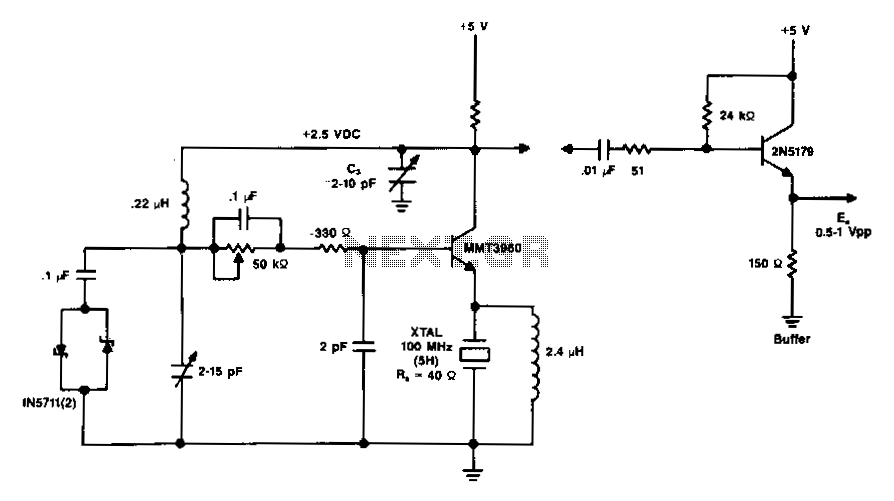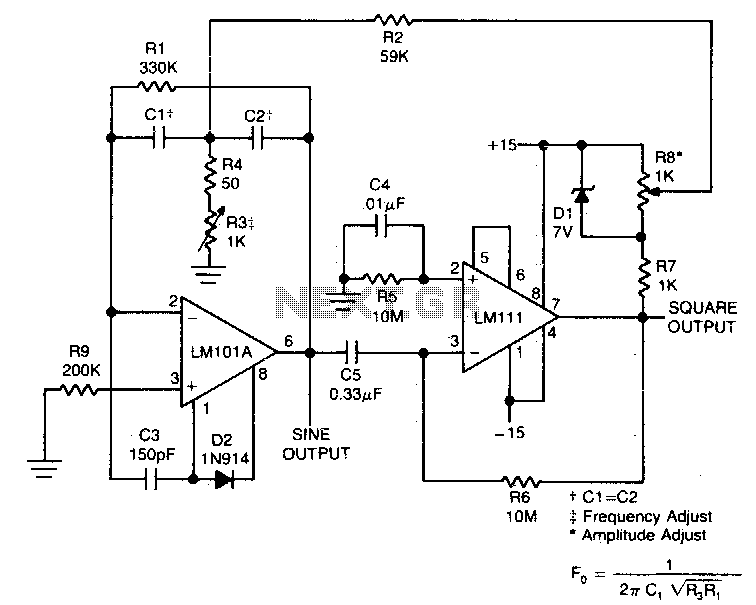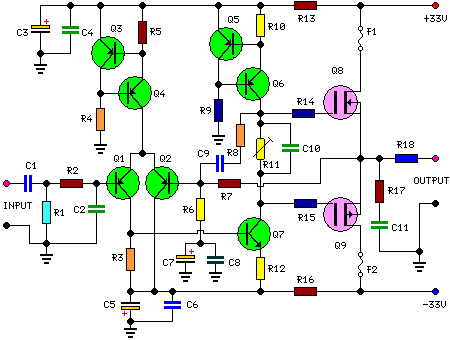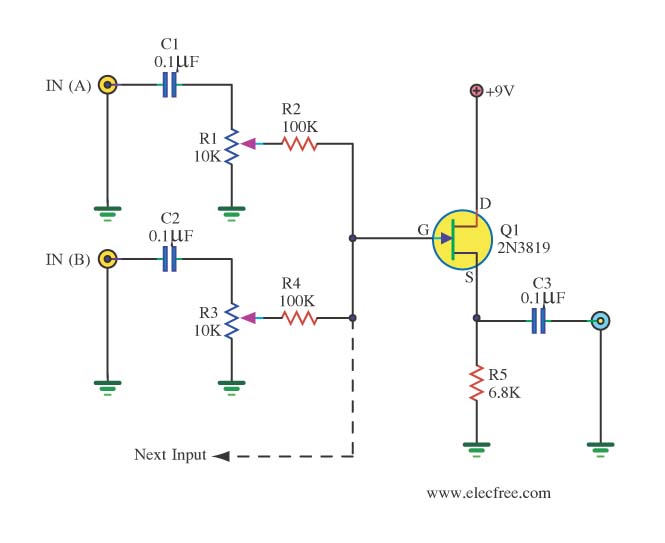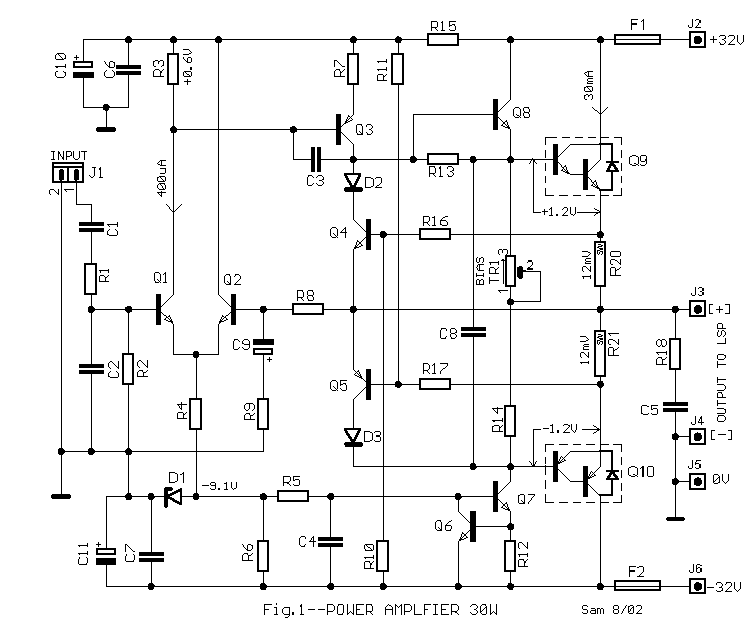
RC Audio Oscillator
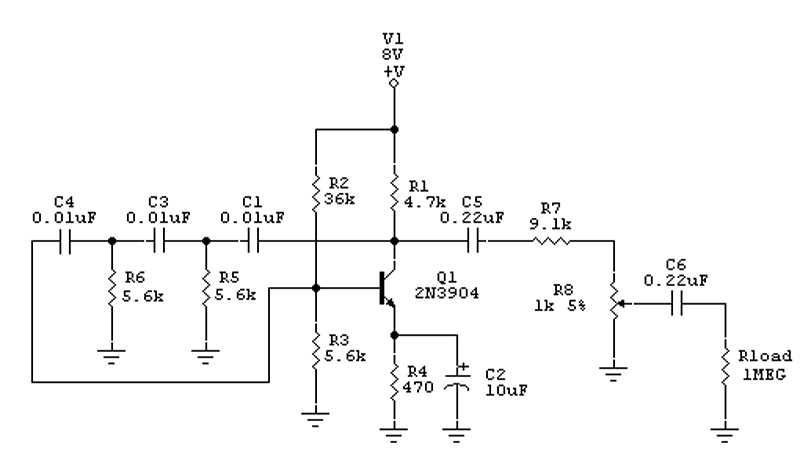
This document presents the design of an audio oscillator that operates at approximately 1 kHz. The circuit is likely sourced from EMFRD, as Wes's book contains a wealth of valuable circuits. This versatile oscillator serves as a signal source for testing audio stages in receivers and can also be utilized as a stable signal source for testing microphone circuits in transmitters. A schematic of the audio oscillator is provided; however, the 8-volt regulator circuitry, which is part of the complete module, is not included. Users can select their preferred components and circuitry for this regulator, as it is not a critical aspect of the design. The schematic offers additional detail regarding the 0.01 µF capacitors, which are the red-orange components in the foreground. These capacitors, in conjunction with the 5.6 kΩ resistors, determine the frequency of oscillation. Users have the option to modify these capacitors to achieve a higher or lower audio tone.
The audio oscillator circuit operates on the principle of generating a periodic waveform, typically a sine or square wave, which is essential for various audio applications. The core of the oscillator is often based on a feedback loop that includes active components such as operational amplifiers or transistors, alongside passive components like resistors and capacitors. In this design, the frequency of oscillation is predominantly influenced by the values of the capacitors and resistors used in the circuit.
The 0.01 µF capacitors play a crucial role in determining the timing characteristics of the oscillator. The frequency \( f \) of the oscillator can be approximated using the formula:
\[
f = \frac{1}{2 \pi R C}
\]
where \( R \) is the resistance in ohms and \( C \) is the capacitance in farads. In this design, the 5.6 kΩ resistors work in tandem with the capacitors to set the desired oscillation frequency around 1 kHz. Adjusting the capacitance by replacing the 0.01 µF capacitors with different values allows for fine-tuning of the output frequency, enabling the generation of various audio tones as needed for testing purposes.
The inclusion of an 8-volt regulator is essential for stabilizing the power supply to the oscillator, ensuring consistent performance across different operating conditions. While the specific regulator design is left to the user's discretion, it is advisable to select a low-dropout regulator (LDO) to maintain efficiency, especially if the oscillator is powered from a battery source.
Overall, this audio oscillator circuit is a practical tool for audio testing and development, providing flexibility in tone generation and stability in operation. The schematic serves as a foundational guide, allowing for customization and adaptation to specific testing requirements in audio electronics.Here is the design of an audio oscillator that runs at approximately 1 KHz. I don`t remember where I got this circuit, probably from EMFRD, since Wes`s book is a treasure trove of useful circuits. This handy oscillator can be used as a source of audio for testing out audio stages in receivers and the like, or as a stable signal source for testing
microphone circuits in transmitter. Aschematic of the audio oscillator. What is not shown is the 8-volt regulator circuitry that is part of the finished module. Just use your favorite part and circuitry there, it isn`t critical at all. This view shows a bit more detail of the 0. 01 uF capacitors, the red-orange units in the foreground, used along with the 5. 6K resistors to set the frequency of oscillation. These capacitors can be changed for a higher or lower audio tone. 🔗 External reference
The audio oscillator circuit operates on the principle of generating a periodic waveform, typically a sine or square wave, which is essential for various audio applications. The core of the oscillator is often based on a feedback loop that includes active components such as operational amplifiers or transistors, alongside passive components like resistors and capacitors. In this design, the frequency of oscillation is predominantly influenced by the values of the capacitors and resistors used in the circuit.
The 0.01 µF capacitors play a crucial role in determining the timing characteristics of the oscillator. The frequency \( f \) of the oscillator can be approximated using the formula:
\[
f = \frac{1}{2 \pi R C}
\]
where \( R \) is the resistance in ohms and \( C \) is the capacitance in farads. In this design, the 5.6 kΩ resistors work in tandem with the capacitors to set the desired oscillation frequency around 1 kHz. Adjusting the capacitance by replacing the 0.01 µF capacitors with different values allows for fine-tuning of the output frequency, enabling the generation of various audio tones as needed for testing purposes.
The inclusion of an 8-volt regulator is essential for stabilizing the power supply to the oscillator, ensuring consistent performance across different operating conditions. While the specific regulator design is left to the user's discretion, it is advisable to select a low-dropout regulator (LDO) to maintain efficiency, especially if the oscillator is powered from a battery source.
Overall, this audio oscillator circuit is a practical tool for audio testing and development, providing flexibility in tone generation and stability in operation. The schematic serves as a foundational guide, allowing for customization and adaptation to specific testing requirements in audio electronics.Here is the design of an audio oscillator that runs at approximately 1 KHz. I don`t remember where I got this circuit, probably from EMFRD, since Wes`s book is a treasure trove of useful circuits. This handy oscillator can be used as a source of audio for testing out audio stages in receivers and the like, or as a stable signal source for testing
microphone circuits in transmitter. Aschematic of the audio oscillator. What is not shown is the 8-volt regulator circuitry that is part of the finished module. Just use your favorite part and circuitry there, it isn`t critical at all. This view shows a bit more detail of the 0. 01 uF capacitors, the red-orange units in the foreground, used along with the 5. 6K resistors to set the frequency of oscillation. These capacitors can be changed for a higher or lower audio tone. 🔗 External reference
